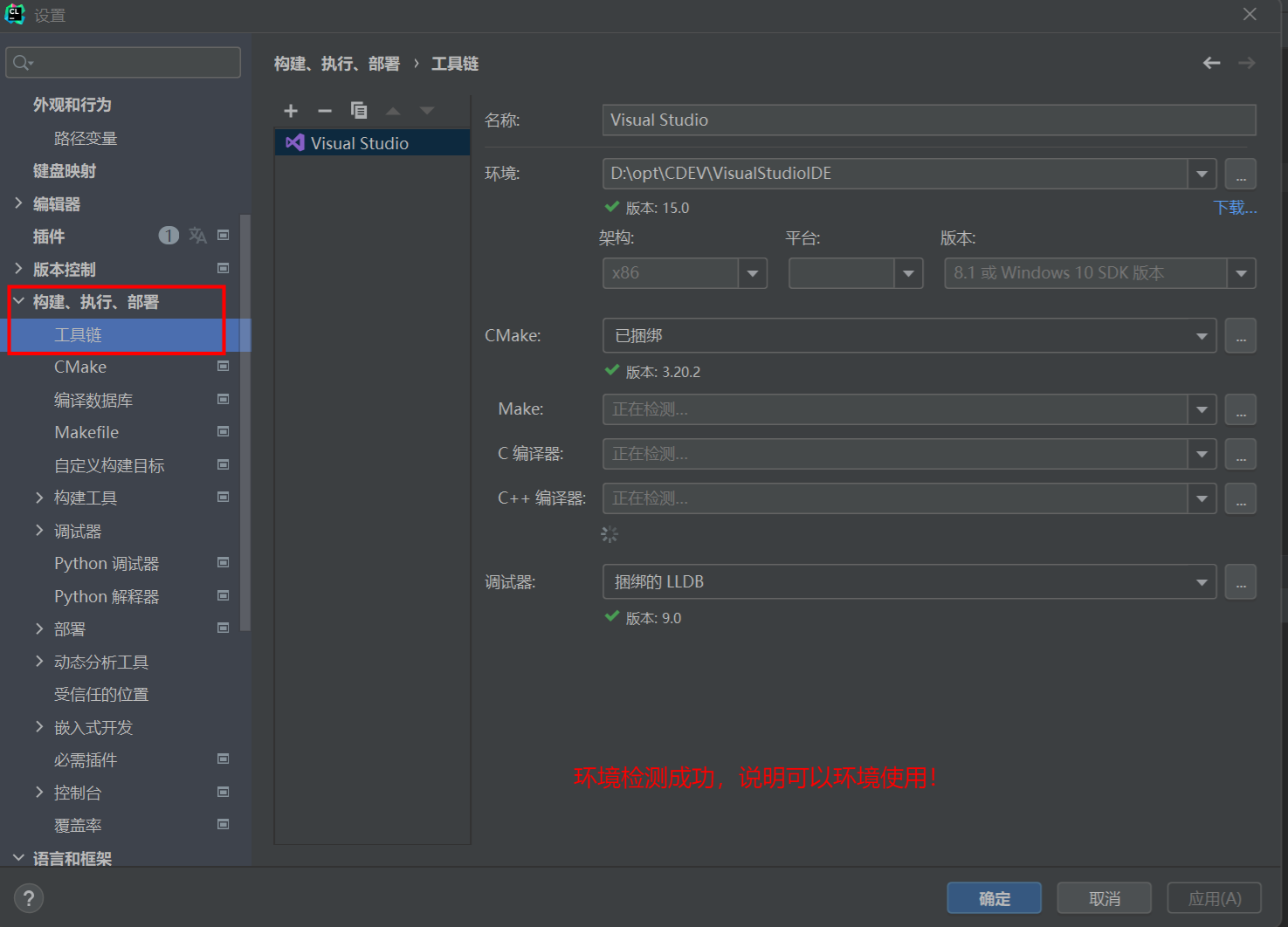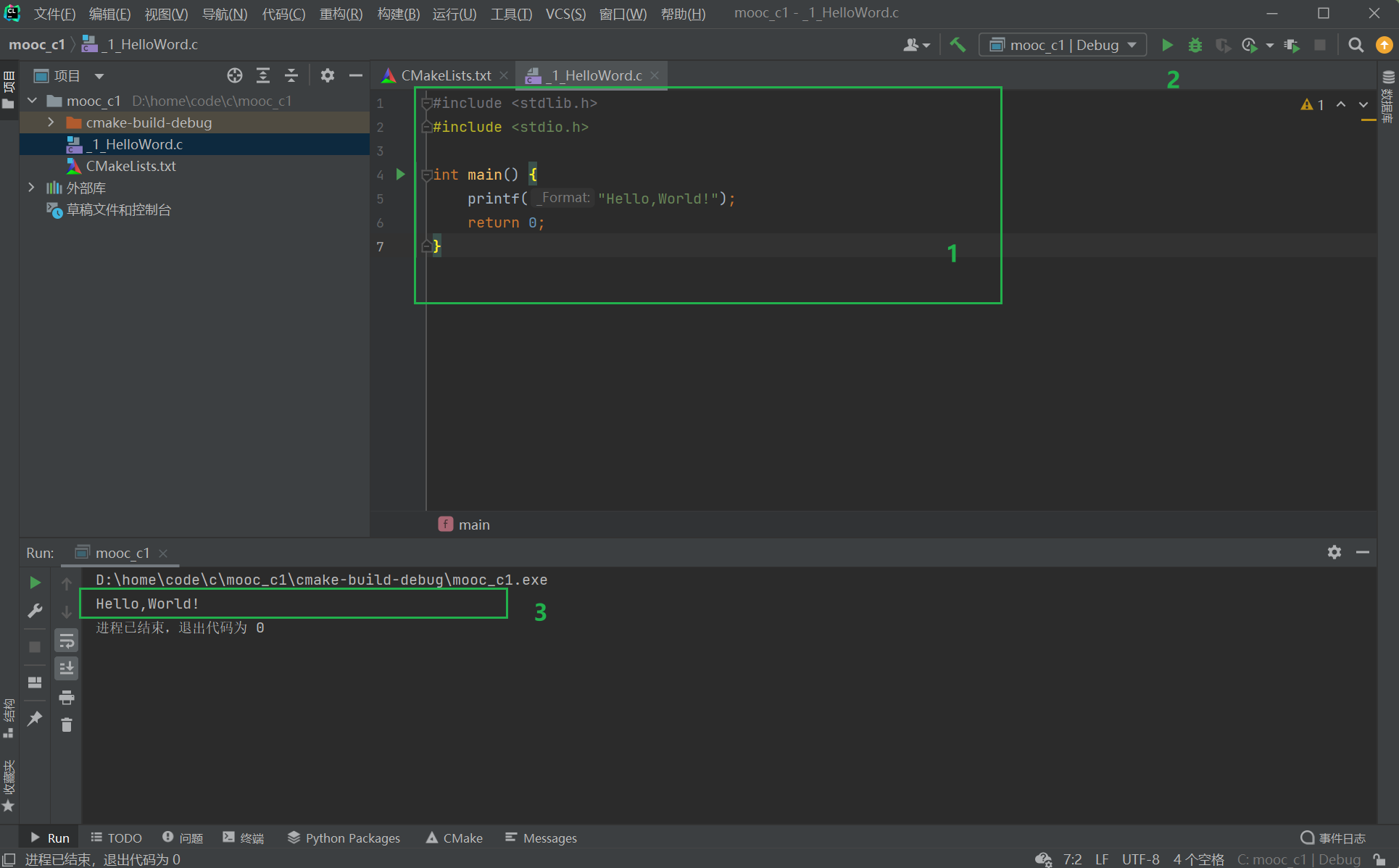1、基本环境


2、学习流程图

3、HelloWord程序

4、更多基础示例
例1:输入a,b,将a,b进行相加得到c,最后输出c
#include <stdio.h>
int main() { int a,b,c; printf("Please input a=?"); scanf("%d",&a); printf("Please input b=?"); scanf("%d",&b); c=a+b; printf("a+b=%d",c); return 0; }
例2:数据类型的定义与输出
#include <stdio.h> int main() { int myint1=1; //定义一个整数类型 double mydouble1=1.34; //定义一个含小数的数据类型 char mychar1='a'; //定义一个字符类型 char* myString1="Hello,World!"; //定义一个字符串数据类型 char myString1array[20]="Hello,World!array"; //自定义一个字符数组,即可以表示字符串类型,20是字符串的长度 const int myconstInt1=1.11; //定义一个int常量,所以下面注释的这行不能再对它进行赋值 //myconstInt1=2.22; /*请记住下面的输出类型对应的表示符号,比如整数是%d*/ printf("%d\n",myint1); printf("%f\n",mydouble1); printf("%d %c\n",mychar1,mychar1); printf("%s\n",myString1); printf("%s\n",myString1array); printf("%d\n",myconstInt1); return 0; }
例3:类型转换
#include <stdio.h> #include <stdlib.h> int main() { /*转为int*/ char* myString1="123"; int toint = atoi(myString1); //1、string转int printf("%d\n",toint); /*转为String*/ int a=123; char s[20]; itoa(a,s,10); //2、int转为 Strigng 其中int是10进制 printf("%s\n",s); /**/ int b=123; double bb=b; //3、int 转为 double printf("%f\n",bb); b=(int)bb; //4、double 需强转为double printf("%d\n",b); return 0; }
例4:变量运算
#include <stdio.h> #include <string.h> #include <math.h> int main() { /*数值运算及基本逻辑运算*/ int a=0,b=1; a=a+b+1; //0+1+1=2 a+=1; //2+1=3 a*=2; //2*3=6 printf("%d",a); a==6? printf("算对了\n"): printf("算错了~\n"); a=pow(a,2); //6^2 printf("平方后:%d\n",a); /*字符运算*/ char* str="Hello"; strcat(str,",World!"); printf("%s",str); return 0; }
例5:逻辑运算
#include <stdio.h> int main() { /*逻辑运算, 0为假,1为值*/ int a = 1; int b = 0; int c = a && b; //与运算 (找假) int d = a || b; //或运算 (找真) int e = !a; //非运算(取反) printf("请调试~\n"); printf("%d-%d-%d", c,d,e); return 0; }
例6:数学运算
#include <stdio.h> #include <math.h> #include <stdlib.h> int main() { /*数学运算*/ int myDouble; const double PI= acos(-1.0); myDouble=PI; myDouble= exp(1); myDouble= sqrt(64); //开方 myDouble= pow(4,2); //4^2 myDouble= ceil(18.54); //上取敕 myDouble= floor(18.54); //下取整 myDouble= sin(30*PI/180); myDouble= fabs(-101); //取绝对值 myDouble= fmod(19,2); //取余 myDouble= rand()%100; //生成0~99的随机数 printf("请自行调试~"); return 0; }
例7:if 语句
#include <stdio.h> int main() { /*数学运算*/ int age = 18; if (age == 18) { printf("刚刚成年~"); } else if(age > 18){ printf("你已经成年了~"); }else { printf("年经真好~"); } return 0; }
例8:switch 语句(与if相近)
#include <stdio.h> int main() { /*数学运算*/ int n = 3; switch (n) { case 1: printf("一级"); break; case 2: printf("二级"); break; default: printf("其它级别"); } return 0; }
例9:循环语句(当知道循环的次数时使用)
#include <stdio.h> int main() { /*for循环*/ for (int i=0; i < 100; i++) { // ..(循环变量初始化; 循环条件; 循环变量更新规则).. printf("循环次数:%d\n",i+1); } return 0; }
例10:while与do while 循环结构
#include <stdio.h> int main() { /* while循环 经常使用*/ int i = 0; while (i < 100) { printf("循环次数: %d\n",i+1); i++; } /* do-while 非常少用*/ printf("===do-while==-\n"); do{ printf("至少执行一次:%d",i); } while (i<100); return 0; }
例11:函数
#include <stdio.h> /*定义一个函数*/ int _max(int a,int b) { if (a>b) { return a; }else { return b; } } /*入口函数调用*/ int main() { /* while循环 经常使用*/ int a=22,b=11,c; c=_max(a,b); printf("%d\n",c); return 0; }
例12:一维数组的定义
#include <stdio.h> int main() { /*定义一个char数组,第一种方式*/ char arr1[3]={'a','b','c'}; /*定义一个char数组,第二种方式*/ char arr2[3]; arr2[0]='a'; arr2[1]='b'; arr2[2]='c'; /*定义一个字符串数组*/ char *sarr[3]={"小庄","大聪明","小聪明"}; printf("请调试~"); return 0; }
例13:二维数组的定义
#include <stdio.h> int main() { //定义一个二行二列的二维数组,即[行数][列数] char arr2[2][2]={{'a','b'},{'c','d'}}; for (int i = 0; i < 2 ; i++) { for (int j = 0; j < 2; j++) { printf("%d-%d:%c\n",i,j,arr2[i][j]); } } printf("--------分割线-----\n"); //定义一个二行二列二维字符串数组 char *srr2[2][2]={{"aa","bb"},{"cc","dd"}}; for (int i = 0; i < 2 ; i++) { for (int j = 0; j < 2; j++) { printf("%d-%d:%s\n",i,j,srr2[i][j]); } } return 0; }
例14:数据结构体
#include <stdio.h> #include <string.h> int main() { /*声明数据结构体*/ struct Student{ int id; char name[20]; } ; /*创建结构体的模版补例*/ struct Student student1; /*向实例中存储数据*/ student1.id=12901; strcpy(student1.name,"大聪明"); /*输出数据*/ printf("%d-%s",student1.id,student1.name); return 0; }
例15:指针(重要)
#include <stdio.h> #include <string.h> int main() { /*指针基本示例内容*/ int a=1; int *p; //声明时*p存的是变量地址 p=&a; //此时的p代表的是地址,取a变量的地址赋值给p , 而*p就是空间即1,这是最基本也是最常用的指针知识点 printf("%d,%p,%d\n",a,p,*p); /*特别地,对数组中的元素进行“前后”运算时*/ int array[3]={1,2,3}; int *p2; p2=&array[0]; printf("%d,%p,%d,%d\n",array[0],p2,*p2,*(p2+1)); return 0; }
例17:文件读写
#include <stdio.h> int main() { FILE *fp; /*文件写*/ char *myfile="d:\\cRead.txt"; char *new_content="写入的内容~"; fp= fopen(myfile,"w"); fputs(new_content,fp); /*文件读*/ fclose(fp); fp= fopen(myfile,"r"); char ts[200]; fgets(ts,50,fp); printf("%s",ts); fclose(fp); return 0; }
知识1: 函数指针
//函数接收函数指针作为参数 void pi(int (*my_max)(int , int), int num1,int num2) { printf("利用传入的函数与数据,得到的max:%d\n",my_max(num1, num2)); } int main() { //声明一个函数指针 int (* p)(int, int) = &max; //传入一个函数指针到其它函数中调用 pi(p,123,22); return 0; }
知识2: 直接创建数据存储结构 & 创建数据类型
//直接创建存储结构 不用 typedef #include <stdio.h> #include <stdlib.h> #include "_4_Tree/tree.h" struct { char *name; char *author; }book; int main() { book.author = "小产"; book.name = "仙人志"; printf("%s的新书叫《%s》\n",book.author,book.name); return 0; } //创建数据类型,应用了 typedef //============================ typedef struct { char *name; char *author; }book; int main() { book *bk = (book *)malloc(sizeof(book)); bk->author = "小产"; bk->name = "仙人志"; printf("%s的新书叫《%s》\n",bk->author,bk->name); return 0; }
知识2: 宏定义
#define 标识符 常量 //注意, 最后没有分号 #C语言中,可以用 #define 定义一个标识符来表示一个常量。其特点是:定义的标识符不占内存,只是一个临时的符号,预编译后这个符号就不存在了。 #一经定义,程序中就可以直接用标识符来表示这个常量。是不是与定义变量类似?但是要区分开!变量名表示的是一个变量,但宏名表示的是一个常量。可以给变量赋值,但绝不能给常量赋值。
#宏所表示的常量可以是数字、字符、字符串、表达式。其中最常用的是数字。